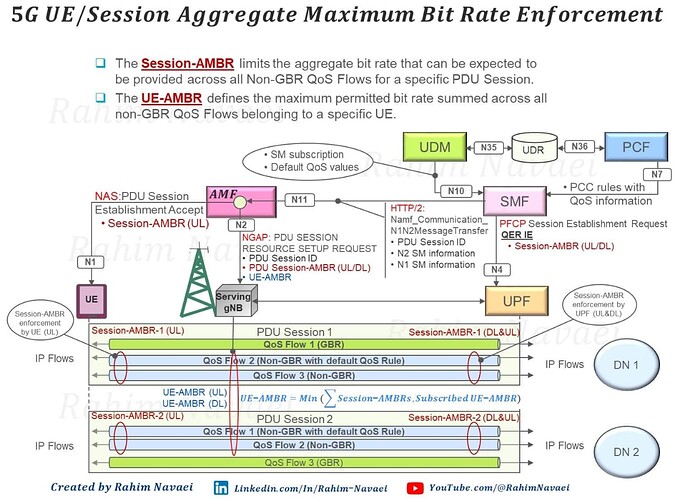-
The 5G QoS model is based on QoS Flows. А PDU Session, which is a logical association between the UE and the PSA UPF (PDU Session Anchour User Plane Function), can transfer one or more QoS Flows. A QoS flow is the finest granularity of QoS differentiation in a PDU session.
-
According to the 3GPP specifications, there are three types of QoS Flows as follows:
- Guaranteed Bit Rate (GBR) QoS Flow: provides а Guaranteed Flow Bit Rate (GFBR) to the end-user.
- Non-Guaranteed Bit Rate (Non-GBR) QoS Flow: does not provide а GFBR to the end-user.
- Delay Critical GBR QoS Flow: provides significantly lower latencies than а GBR QoS Flow.
-
For each PDU Session, the Session Aggregate Maximum Bit Rate (Session-AMBR) defines the maximum permitted bit rate summed across all non-GBR QoS Flows. It can be specified independently for the uplink and downlink, and is enforced by the UE and UPF fог the relevant PDU Session. In case of UE, only Session-AMBR parameter in the uplink direction is provided by the 5G core.
-
If multiple PDU Sessions are created between the UE and the PSA UPFs, The UE Aggregate Maximum Bit Rate (UE -AМBR) defines the maximum permitted bit rate summed across all non-GBR QoS Flows belonging to а specific UE. The UE-AMBR is а subscription parameter which is retrieved by the Session Management Function (SMF) from the Unified Data Management (UDM) parameter and is delivered to the gNB using New Generation Application Protocol (NGAP) via N2 interface by the Access and Mobility Management Function (AMF).
-
Here I try to depict how the maximum bit rate is enforced to the data packets exchanged between the UE and the Data Networks by the entities in the user plane path of the 5G system.
LinkedIn: ![]()
